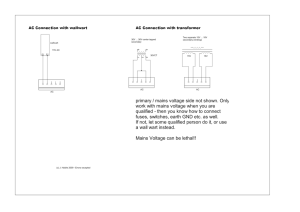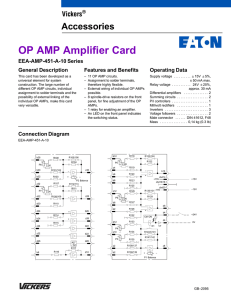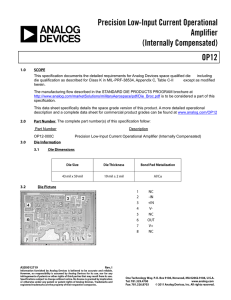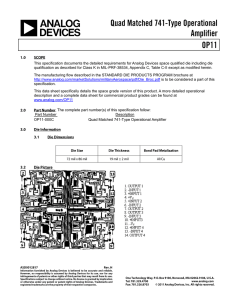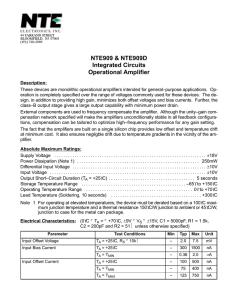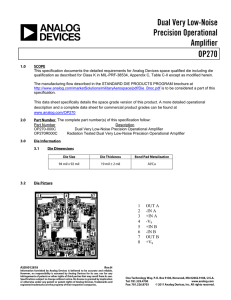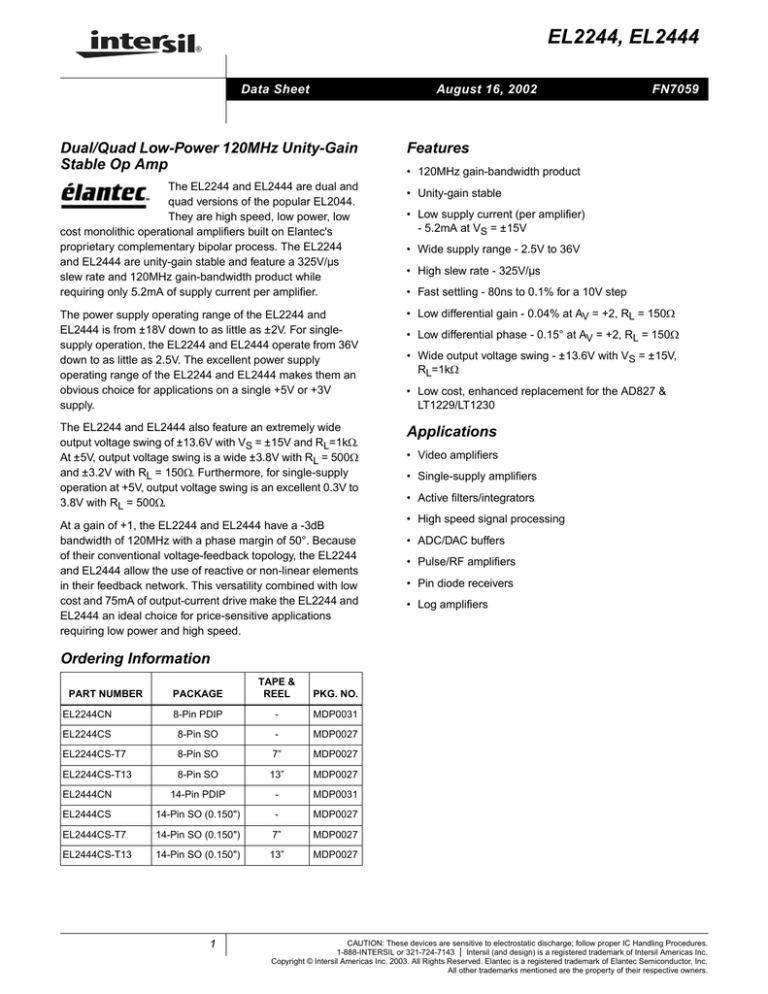
EL2244, EL2444
®
Data Sheet
August 16, 2002
Dual/Quad Low-Power 120MHz Unity-Gain
Stable Op Amp
The EL2244 and EL2444 are dual and
quad versions of the popular EL2044.
They are high speed, low power, low
cost monolithic operational amplifiers built on Elantec's
proprietary complementary bipolar process. The EL2244
and EL2444 are unity-gain stable and feature a 325V/µs
slew rate and 120MHz gain-bandwidth product while
requiring only 5.2mA of supply current per amplifier.
FN7059
Features
• 120MHz gain-bandwidth product
• Unity-gain stable
• Low supply current (per amplifier)
- 5.2mA at VS = ±15V
• Wide supply range - 2.5V to 36V
• High slew rate - 325V/µs
• Fast settling - 80ns to 0.1% for a 10V step
The power supply operating range of the EL2244 and
EL2444 is from ±18V down to as little as ±2V. For singlesupply operation, the EL2244 and EL2444 operate from 36V
down to as little as 2.5V. The excellent power supply
operating range of the EL2244 and EL2444 makes them an
obvious choice for applications on a single +5V or +3V
supply.
• Low differential gain - 0.04% at AV = +2, RL = 150Ω
The EL2244 and EL2444 also feature an extremely wide
output voltage swing of ±13.6V with VS = ±15V and RL=1kΩ.
At ±5V, output voltage swing is a wide ±3.8V with RL = 500Ω
and ±3.2V with RL = 150Ω. Furthermore, for single-supply
operation at +5V, output voltage swing is an excellent 0.3V to
3.8V with RL = 500Ω.
Applications
At a gain of +1, the EL2244 and EL2444 have a -3dB
bandwidth of 120MHz with a phase margin of 50°. Because
of their conventional voltage-feedback topology, the EL2244
and EL2444 allow the use of reactive or non-linear elements
in their feedback network. This versatility combined with low
cost and 75mA of output-current drive make the EL2244 and
EL2444 an ideal choice for price-sensitive applications
requiring low power and high speed.
• Low differential phase - 0.15° at AV = +2, RL = 150Ω
• Wide output voltage swing - ±13.6V with VS = ±15V,
RL=1kΩ
• Low cost, enhanced replacement for the AD827 &
LT1229/LT1230
• Video amplifiers
• Single-supply amplifiers
• Active filters/integrators
• High speed signal processing
• ADC/DAC buffers
• Pulse/RF amplifiers
• Pin diode receivers
• Log amplifiers
Ordering Information
PACKAGE
TAPE &
REEL
PKG. NO.
EL2244CN
8-Pin PDIP
-
MDP0031
EL2244CS
8-Pin SO
-
MDP0027
EL2244CS-T7
8-Pin SO
7”
MDP0027
EL2244CS-T13
8-Pin SO
13”
MDP0027
EL2444CN
14-Pin PDIP
-
MDP0031
EL2444CS
14-Pin SO (0.150")
-
MDP0027
EL2444CS-T7
14-Pin SO (0.150")
7”
MDP0027
EL2444CS-T13
14-Pin SO (0.150")
13”
MDP0027
PART NUMBER
1
CAUTION: These devices are sensitive to electrostatic discharge; follow proper IC Handling Procedures.
1-888-INTERSIL or 321-724-7143 | Intersil (and design) is a registered trademark of Intersil Americas Inc.
Copyright © Intersil Americas Inc. 2003. All Rights Reserved. Elantec is a registered trademark of Elantec Semiconductor, Inc.
All other trademarks mentioned are the property of their respective owners.
EL2244, EL2444
Pinouts
EL2444
[14-PIN SO (0.150”), PDIP]
TOP VIEW
EL2244
(8-PIN SO, PDIP)
TOP VIEW
OUT
1
IN1-
2
IN1+
3
V-
4
+
8
V+
7
OUT2
6
IN2-
5
IN2+
+
2
OUT1
1
14 OUT4
IN1-
2
IN1+
3
12 IN4+
V+
4
11 V-
IN2+
5
10 IN3+
IN2-
6
OUT2
7
-
-
+
+
+
+
-
-
13 IN4-
9
IN3-
8
OUT3
EL2244, EL2444
Absolute Maximum Ratings (TA = 25°C)
Supply Voltage (VS) . . . . . . . . . . . . . . . . . . . . . . . . . . . . ±18V or 36V
Input Voltage (VIN) . . . . . . . . . . . . . . . . . . . . . . . . . . . . . . . . . . . ±VS
Differential Input Voltage (dVIN) . . . . . . . . . . . . . . . . . . . . . . . . .±10V
Continuous Output Current . . . . . . . . . . . . . . . . . . . . . . . . . . . 40mA
Power Dissipation (PD) . . . . . . . . . . . . . . . . . . . . . . . . . See Curves
Operating Temperature Range (TA) . . . . . . . . . . . . . .-40°C to +85°C
Operating Junction Temperature (TJ) . . . . . . . . . . . . . . . . . . +150°C
Storage Temperature (TST) . . . . . . . . . . . . . . . . . . .-65°C to +150°C
CAUTION: Stresses above those listed in “Absolute Maximum Ratings” may cause permanent damage to the device. This is a stress only rating and operation of the
device at these or any other conditions above those indicated in the operational sections of this specification is not implied.
IMPORTANT NOTE: All parameters having Min/Max specifications are guaranteed. Typical values are for information purposes only. Unless otherwise noted, all tests
are at the specified temperature and are pulsed tests, therefore: TJ = TC = TA
DC Electrical Specifications
PARAMETER
VOS
VS = ±15V, RL = 1kΩ, unless otherwise specified.
DESCRIPTION
Input Offset Voltage
CONDITION
VS = ±15V
TEMP
MIN
25°C
TYP
MAX
UNIT
0.5
4.0
mV
9.0
mV
TMIN, TMAX
TCVOS
Average Offset Voltage
Drift
(Note 1)
IB
Input Bias Current
VS = ±15V
All
10.0
25°C
2.8
TMIN, TMAX
IOS
Input Offset Current
VS = ±5V
25°C
2.8
VS = ±15V
25°C
50
TMIN, TMAX
µA
300
nA
500
nA
All
0.3
nA/°C
1500
V/V
Open-Loop Gain
VS = ±15V, VOUT = ±10V, RL = 1kΩ
ISC
µA
nA
AVOL
VOUT
11.2
50
(Note 1)
CMIR
µA
25°C
Average Offset Current
Drift
CMRR
8.2
VS = ±5V
TCIOS
PSRR
µV/°C
25°C
800
TMIN, TMAX
600
V/V
VS = ±5V, VOUT = ±2.5V, RL = 500Ω
25°C
1200
V/V
VS = ±5V, VOUT = ±2.5V, RL = 150Ω
25°C
1000
V/V
Power Supply Rejection
Ratio
VS = ±5V to ±15V
25°C
65
80
dB
TMIN, TMAX
60
Common-mode
Rejection Ratio
VCM = ±12V, VOUT = 0V
25°C
70
TMIN, TMAX
70
Common-mode Input
Range
VS = ±15V
25°C
±14.0
V
VS = ±5V
25°C
±4.2
V
VS = +5V
25°C
4.2/0.1
V
VS = ±15V, RL = 1kΩ
25°C
±13.4
±13.6
V
TMIN, TMAX
±13.1
VS = ±15V, RL = 500Ω
25°C
±12.0
±13.4
V
VS = ±5V, RL = 500Ω
25°C
±3.4
±3.8
V
VS = ±5V, RL = 150Ω
25°C
±3.2
V
VS = +5V, RL = 500Ω
25°C
3.6/0.4
3.8/0.3
V
TMIN, TMAX
3.5/0.5
25°C
40
TMIN, TMAX
35
Output Voltage Swing
Output Short Circuit
Current
3
dB
90
dB
dB
V
V
75
mA
mA
EL2244, EL2444
DC Electrical Specifications
PARAMETER
IS
VS = ±15V, RL = 1kΩ, unless otherwise specified. (Continued)
DESCRIPTION
Supply Current
(per amplifier)
RIN
CONDITION
VS = ±15V, no load
Input Resistance
TEMP
MIN
TYP
MAX
UNIT
5.2
7
mA
TMIN
7.6
mA
TMAX
7.6
mA
25°C
VS = ±5V, no load
25°C
5.0
mA
Differential
25°C
150
kΩ
Common-mode
25°C
15
MΩ
CIN
Input Capacitance
AV = +1 @10MHz
25°C
1.0
pF
ROUT
Output Resistance
AV = +1
25°C
50
mΩ
PSOR
Power-Supply Operating Dual-supply
Range
Single-supply
25°C
±2.0
±18.0
V
25°C
2.5
36.0
V
NOTE:
1. Measured from TMIN to TMAX.
Closed-Loop AC Electrical Specifications VS = ±15V, AV = +1, RL = 1kΩ, unless otherwise specified.
PARAMETER
BW
DESCRIPTION
-3dB Bandwidth
(VOUT = 0.4VPP)
CONDITION
TEMP
MIN
TYP
MAX
UNIT
VS = ±15V, AV = +1
25°C
120
MHz
VS = ±15V, AV = -1
25°C
60
MHz
VS = ±15V, AV = +2
25°C
60
MHz
VS = ±15V, AV = +5
25°C
12
MHz
VS = ±15V, AV = +10
25°C
6
MHz
VS = ±5V, AV = +1
25°C
80
MHz
GBWP
Gain-Bandwidth Product
VS = ±15V
25°C
60
MHz
VS = ±5V
25°C
45
MHz
PM
Phase Margin
RL = 1kΩ, CL = 10pF
25°C
50
°
CS
Channel Separation
f = 5MHz
25°C
SR
Slew Rate (Note 1)
VS = ±15V, RL = 1kΩ
25°C
VS = ±5V, RL = 500Ω
25°C
FPBW
Full-Power Bandwidth
(Note 2)
VS = ±15V
25°C
VS = ±5V
tR, tF
Rise Time, Fall Time
0.1V step
OS
Overshoot
0.1V step
25°C
20
%
tPD
Propagation Delay
25°C
2.5
ns
tS
Settling to +0.1% (AV = +1)
VS = ±15V, 10V step
25°C
80
ns
VS = ±5V, 5V step
25°C
60
ns
250
85
dB
325
V/µs
200
V/µs
5.2
MHz
25°C
12.7
MHz
25°C
3.0
ns
4.0
dG
Differential Gain (Note 3)
NTSC/PAL
25°C
0.04
%
dP
Differential Phase (Note 3)
NTSC/PAL
25°C
0.15
°
eN
Input Noise Voltage
10kHz
25°C
15.0
nV/√Hz
iN
Input Noise Current
10kHz
25°C
1.50
pA/√Hz
NOTES:
1. Slew rate is measured on rising edge
2. For VS = ±15V, VOUT = 20VPP. For VS = ±5V, VOUT = 5VPP. Full-power bandwidth is based on slew rate measurement using: FPBW = SR /
(2π * Vpeak).
3. Video performance measured at VS = ±15V, AV = +2 with 2 times normal video level across RL = 150Ω. This corresponds to standard video levels
across a back-terminated 75Ω load. For other values of RL, see curves.
4
EL2244, EL2444
Typical Performance Curves
Non-Inverting
Frequency Response
Inverting Frequency Response
Frequency Response for
Various Load Resistances
Open-Loop Gain and
Phase vs Frequency
Output Voltage Swing
vs Frequency
Equivalent Input Noise
CMRR, PSRR and Closed-Loop
Output Resistance vs Frequency
2nd and 3rd Harmonic
Distortion vs Frequency
Settling Time vs
Output Voltage Change
Supply Current vs
Supply Voltage
Common-Mode Input Range
vs Supply Voltage
Output Voltage Range
vs Supply Voltage
5
EL2244, EL2444
Typical Performance Curves
(Continued)
Gain-Bandwidth Product
vs Supply Voltage
Bias and Offset Current
vs Input Common-Mode Voltage
Open-Loop Gain
vs Supply Voltage
Open-Loop Gain
vs Load Resistance
Slew-Rate vs
Supply Voltage
Voltage Swing
vs Load Resistance
Offset Voltage
vs Temperature
Bias and Offset
Current vs Temperature
Supply Current
vs Temperature
Gain-Bandwidth Product
vs Temperature
Open-Loop Gain, PSRR
and CMRR vs Temperature
Slew Rate vs
Temperature
Short-Circuit Current
vs Temperature
6
Small-Signal
Step Response
Large-Signal
Step Response
EL2244, EL2444
Typical Performance Curves
(Continued)
Differential Gain and
Phase vs DC Input
Offset at 3.58MHz
Differential Gain and
Phase vs DC Input
Offset at 4.43MHz
Differential Gain and
Phase vs Number of
150Ω Loads at 4.43MHz
Channel Separation
vs Frequency
Gain-Bandwidth Product vs Load Capacitance
Overshoot vs Load Capacitance
60
60
Gain-Bandwidth Product (MHz)
VS=±15V
RG=Open
50
40
Overshoot (%)
Differential Gain and
Phase vs Number of
150Ω Loads at 3.58MHz
30
20
10
50
40
30
20
10
VS=±15V
AV=-2
0
0
5
10
15
20
25
30
35
40
45
1
50
10
1.471W
1.4
PDIP14
θJA=70°C/W
PDIP8
θJA=85°C/W
1.420W
1.2
1.136W
1
0.8
0.6
SO14
θJA=88°C/W
0.4
1.54W
1.6
Power Dissipation (W)
Power Dissipation (W)
1.6
10k
1.8
2
1.786W
1k
Package Power Dissipation vs Ambient Temperature
JEDEC JESD51-3 Low Effective Thermal Conductivity Test
Board
Package Power Dissipation vs Ambient Temperature
JEDEC JESD51-7 High Effective Thermal Conductivity Test
Board
1.8
100
Load Capacitance (pF)
Load Capacitance (pF)
SO8
θJA=110°C/W
1.4
1.2
1
PDIP8
θJA=100°C/W
1.042W
0.8
781mW
0.6
0.4
SO8
θJA=160°C/W
0.2
0.2
PDIP14
θJA=81°C/W
1.25W
SO14
θJA=120°C/W
0
0
0
25
50
75 85 100
Ambient Temperature (°C)
7
125
150
0
25
50
75 85 100
Ambient Temperature (°C)
125
150
EL2244, EL2444
Simplified Schematic (Per Amplifier)
calculate the maximum junction temperature (TJMAX) for all
applications to determine if power supply voltages, load
conditions, or package type need to be modified for the
EL2244 and EL2444 to remain in the safe operating area.
These parameters are related as follows:
T JMAX = T MAX + ( Θ JA × PD MAXTOTAL )
where:
PDMAXTOTAL is the sum of the maximum power dissipation
of each amplifier in the package (PDMAX). PDMAX for each
amplifier can be calculated as follows:
V OUTMAX
PD MAX = 2 × V S × I SMAX + ( V S - V OUTMAX ) × ---------------------------RL
where:
Burn-In Circuit (Per Amplifier)
TMAX = Maximum ambient temperature
θJA = Thermal resistance of the package
PDMAX = Maximum power dissipation of each amplifier
VS = Supply voltage
ISMAX = Maximum supply current of each amplifier
VOUTMAX = Maximum output voltage swing of the
application
RL = Load resistance
ALL PACKAGES USE THE SAME SCHEMATIC
Applications Information
Product Description
The EL2244 and EL2444 are low-power wideband
monolithic operational amplifiers built on Elantec's
proprietary high-speed complementary bipolar process. The
EL2244 and EL2444 use a classical voltage-feedback
topology which allows them to be used in a variety of
applications where current-feedback amplifiers are not
appropriate because of restrictions placed upon the
feedback element used with the amplifier. The conventional
topology of the EL2244 and EL2444 allows, for example, a
capacitor to be placed in the feedback path, making it an
excellent choice for applications such as active filters,
sample-and-holds, or integrators. Similarly, because of the
ability to use diodes in the feedback network, the EL2244
and EL2444 are an excellent choice for applications such as
fast log amplifiers.
Power Dissipation
With the wide power supply range and large output drive
capability of the EL2244 and EL2444, it is possible to exceed
the 150°C maximum junction temperatures under certain
load and power-supply conditions. It is therefore important to
8
To serve as a guide for the user, we can calculate maximum
allowable supply voltages for the example of the video cabledriver below since we know that TJMAX = 150°C, TMAX =
85°C, ISMAX = 7.6mA per amplifier, and the package θJAs
are shown in Table 1. If we assume (for this example) that we
are driving a back-terminated video cable, then the
maximum average value (over duty-cycle) of VOUTMAX is
1.4V, and RL = 150Ω, giving the results seen in Table 1.
TABLE 1.
PACKAGE
ΘJA
MAX PDISS
@TMAX
MAX VS
EL2244CN
PDIP8
100°C/W
0.650W @85°C
±16.6V
EL2244CS
SO8
160°C/W
0.406W @85°C
±10.5V
EL2444CN
PDIP14
81°C/W
0.802W @85°C
±11.5V
EL2444CS
SO14
120°C/W
0.542W @85°C
±7.5V
PART
DUALS
QUADS
Single-Supply Operation
The EL2244 and EL2444 have been designed to have a
wide input and output voltage range. This design also makes
the EL2244 and EL2444 an excellent choice for singlesupply operation. Using a single positive supply, the lower
input voltage range is within 100mV of ground (RL = 500Ω),
EL2244, EL2444
and the lower output voltage range is within 300mV of
ground. Upper input voltage range reaches 4.2V, and output
voltage range reaches 3.8V with a 5V supply and RL = 500Ω.
This results in a 3.5V output swing on a single 5V supply.
This wide output voltage range also allows single-supply
operation with a supply voltage as high as 36V or as low as
2.5V. On a single 2.5V supply, the EL2244 and EL2444 still
have 1V of output swing.
Gain-Bandwidth Product and the -3dB Bandwidth
The EL2244 and EL2444 have a gain-bandwidth product of
120MHz while using only 5.2mA of supply current per
amplifier. For gains greater than 4, their closed-loop -3dB
bandwidth is approximately equal to the gain-bandwidth
product divided by the noise gain of the circuit. For gains
less than 4, higher-order poles in the amplifiers' transfer
function contribute to even higher closed loop bandwidths.
For example, the EL2244 and EL2444 have a -3dB
bandwidth of 120MHz at a gain of +1, dropping to 60MHz at
a gain of +2. It is important to note that the EL2244 and
EL2444 have been designed so that this “extra” bandwidth in
low-gain applications does not come at the expense of
stability. As seen in the typical performance curves, the
EL2244 and EL2444 in a gain of +1 only exhibit 1.0dB of
peaking with a 1kΩ load.
Video Performance
An industry-standard method of measuring the video
distortion of components such as the EL2244 and EL2444 is
to measure the amount of differential gain (dG) and
differential phase (dP) that they introduce. To make these
measurements, a 0.286VPP (40 IRE) signal is applied to the
device with 0V DC offset (0 IRE) at either 3.58MHz for NTSC
or 4.43MHz for PAL. A second measurement is then made at
0.714V DC offset (100 IRE). Differential gain is a measure of
the change in amplitude of the sine wave, and is measured
in percent. Differential phase is a measure of the change in
phase, and is measured in degrees.
For signal transmission and distribution, a back-terminated
cable (75Ω in series at the drive end, and 75Ω to ground at
the receiving end) is preferred since the impedance match at
both ends will absorb any reflections. However, when double
termination is used, the received signal is halved; therefore a
gain of 2 configuration is typically used to compensate for
the attenuation.
The EL2244 and EL2444 have been designed as an
economical solution for applications requiring low video
distortion. They have been thoroughly characterized for
video performance in the topology described above, and the
results have been included as typical dG and dP
specifications and as typical performance curves. In a gain
of +2, driving 150Ω, with standard video test levels at the
input, the EL2244 and EL2444 exhibit dG and dP of only
0.04% and 0.15° at NTSC and PAL. Because dG and dP can
vary with different DC offsets, the video performance of the
9
EL2244 and EL2444 has been characterized over the entire
DC offset range from -0.714V to +0.714V. For more
information, refer to the curves of dG and dP vs DC Input
Offset.
Output Drive Capability
The EL2244 and EL2444 have been designed to drive low
impedance loads. They can easily drive 6VPP into a 150Ω
load. This high output drive capability makes the EL2244
and EL2444 an ideal choice for RF, IF and video
applications. Furthermore, the current drive of the EL2244
and EL2444 remains a minimum of 35mA at low
temperatures.
Printed-Circuit Layout
The EL2244 and EL2444 are well behaved, and easy to
apply in most applications. However, a few simple
techniques will help assure rapid, high quality results. As
with any high-frequency device, good PCB layout is
necessary for optimum performance. Ground-plane
construction is highly recommended, as is good power
supply bypassing. A 0.1µF ceramic capacitor is
recommended for bypassing both supplies. Lead lengths
should be as short as possible, and bypass capacitors
should be as close to the device pins as possible. For good
AC performance, parasitic capacitances should be kept to a
minimum at both inputs and at the output. Resistor values
should be kept under 5kΩ because of the RC time constants
associated with the parasitic capacitance. Metal-film and
carbon resistors are both acceptable, use of wire-wound
resistors is not recommended because of their parasitic
inductance. Similarly, capacitors should be low-inductance
for best performance.
The EL2244 and EL2444 Macromodel
This macromodel has been developed to assist the user in
simulating the EL2244 and EL2444 with surrounding
circuitry. It has been developed for the PSPICE simulator
(copywritten by the Microsim Corporation), and may need to
be rearranged for other simulators. It approximates DC, AC,
and transient response for resistive loads, but does not
accurately model capacitive loading. This model is slightly
more complicated than the models used for low-frequency
op-amps, but it is much more accurate for AC analysis.
The model does not simulate these characteristics
accurately:
• Noise
• Settling time
• Non-linearities
• Temperature effects
• Manufacturing variations
• CMRR
• PSRR
EL2244, EL2444
EL2244 and EL244C Macromodel
* Connections: +input
*
| -input
*
|
| +Vsupply
*
|
|
| -Vsupply
*
|
|
|
| output
*
|
|
|
|
|
.subckt M2244 3 2 7 4 6
*
* Input stage
*
ie 7 37 1mA
r6 36 37 800
r7 38 37 800
rc1 4 30 850
rc2 4 39 850
q1 30 3 36 qp
q2 39 2 38 qpa
ediff 33 0 39 30 1.0
rdiff 33 0 1Meg
*
* Compensation Section
*
ga 0 34 33 0 1m
rh 34 0 2Meg
ch 34 0 1.3pF
rc 34 40 1K
cc 40 0 1pF
*
* Poles
*
ep 41 0 40 0 1
rpa 41 42 200
cpa 42 0 1pF
rpb 42 43 200
cpb 43 0 1pF
*
* Output Stage
*
ios1 7 50 1.0mA
ios2 51 4 1.0mA
q3 4 43 50 qp
q4 7 43 51 qn
q5 7 50 52 qn
q6 4 51 53 qp
ros1 52 6 25
ros2 6 53 25
*
* Power Supply Current
*
ips 7 4 2.7mA
*
* Models
*
.model qn npn(is=800E-18 bf=200 tf=0.2nS)
.model qpa pnp(is=864E-18 bf=100 tf=0.2nS)
.model qp pnp(is=800E-18 bf=125 tf=0.2nS)
.ends
10
EL2244, EL2444
EL2244 and EL2444 Macromodel (Continued)
All Intersil U.S. products are manufactured, assembled and tested utilizing ISO9000 quality systems.
Intersil Corporation’s quality certifications can be viewed at www.intersil.com/design/quality
Intersil products are sold by description only. Intersil Corporation reserves the right to make changes in circuit design, software and/or specifications at any time without
notice. Accordingly, the reader is cautioned to verify that data sheets are current before placing orders. Information furnished by Intersil is believed to be accurate and
reliable. However, no responsibility is assumed by Intersil or its subsidiaries for its use; nor for any infringements of patents or other rights of third parties which may result
from its use. No license is granted by implication or otherwise under any patent or patent rights of Intersil or its subsidiaries.
For information regarding Intersil Corporation and its products, see www.intersil.com
11

